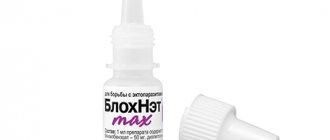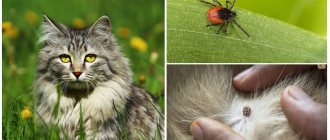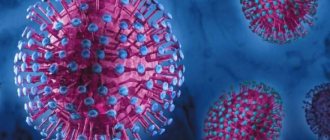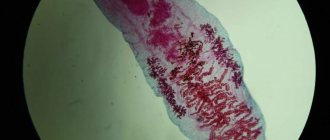Sarcoptic mange not only causes a certain discomfort and real physical suffering to the pet, but also significantly spoils the appearance of the animal, worsening the condition of the skin and ruffled fur. The cat becomes irritable with sudden bouts of aggressiveness due to unbearable, constant itching.
The disease is unpleasant and definitely requires a special therapeutic approach due to the peculiarities of the development cycle of the parasite. What owners of mustachioed pets should pay attention to in order to promptly seek veterinary help.
Sarcoptic mange and its characteristics
The most unpleasant thing about itchy scabies for a cat is the loss of its healthy appearance, the appearance of bald spots, scratches, and pustules. Against the background of these signs, the breeder is afraid of becoming infected himself, but these fears are only half scary. Theoretically, Sarcoptes can bite a person, causing itching, but it cannot penetrate into the thickness of the epidermis and multiply there.
Pseudosarcoptosis is a condition when itchy patches of irritation appear on the skin, usually disappearing after 2-3 weeks without a trace or treatment. To protect yourself, you must follow the rules for working with a sick cat (gloves) and keep your pet away from other family members during the treatment period. All soft accessories (beds, rugs) are washed, and floors, carpets and upholstered furniture are treated.
A little explanation:
- The full course of treatment for sarcoptic mange is 2-8 weeks, since there are no drugs that affect the eggs of the parasite. If a secondary infection or allergy occurs, therapy may be delayed;
- Sarcoptic mange can be treated at home, but with the condition of using specific veterinary drugs and only after consultation and prescriptions from a veterinary parasitologist at the RosVet VC;
- The danger of Sarcoptes parasitism is that fungi and bacteria easily penetrate damaged skin, causing dermatitis. Therefore, along with the treatment of sarcoptic mange, the use of antifungal, antiallergic and antibacterial agents is necessary.
Treatment and prevention
Treatment at home begins with complete isolation of the sick pet from other animals.
In relation to things related to it, you can do the following:
The sick animal is isolated during treatment.
- burn;
- freeze for 24 hours at a temperature below – 10°C;
- treat with a solution of an antiparasitic drug effective against scabies mites (neostomozan, etc.); Wipe surfaces and wash floors with the same solution.
It is recommended to repeat the treatment several times - every 7-10 days. This will prevent re-infection.
It is advisable to bathe the animal using special products, for example, Doctor shampoo: this will help reduce itching and cleanse the skin. After this, antiparasitic agents and other medications prescribed by your veterinarian should be applied. The shampoo can be used daily or once every 2-3 days.
Further treatment proceeds in three directions.
Destruction of parasites
The most effective remedy is Stronghold 6% drops on the withers. It is allowed to be used for kittens from 2.5 months . The solution is dripped between the shoulder blades, closer to the base of the neck, strictly onto dry, undamaged skin . The following dosage is used: for cats weighing less than 2.5 kg - 0.25 ml (pipette with a purple cap), weighing more than 2.5 kg - 0.75 ml (pipette with a blue cap). After a month, repeat the procedure (or earlier - as prescribed by the doctor).
To prevent the pussy from getting tricky and licking the solution, it is recommended to put a special collar on it for at least two hours. During this time, people should not touch the treated area. It should be noted that some veterinarians do not advise bathing a cat two days before and after using stronghold. However, according to official instructions, this period is two hours.
Antibacterial therapy
It is better to remove fur from the affected skin using a fine comb. It is fixed at its roots, as when combing, and the hair is cut off above it. This method will prevent you from accidentally injuring the skin.
Levomekol is used to treat sarcoptic mange in cats.
After cleansing with hydrogen peroxide or a weak solution of manganese, bleeding and purulent wounds are lubricated with levomekol ointment. If the infected area is large, then sterile gauze pads (sold at a regular pharmacy) are soaked in the ointment and secured with a bandage or blanket. Do not use other ointments at the same time. To prevent licking of the drug, a special collar is put on the cat.
Important. In case of advanced disease, it is possible to use antibiotics and macrolides in injections - but only as prescribed by a veterinarian.
Restoring and maintaining immunity
Nutrition during this period should be rich in vitamins and minerals. When feeding with natural food, the diet will include beef, offal (heart, stomach), kefir, homemade cottage cheese, sprouted grains of wheat or oats, and boiled carrots. A sick pet can be offered mixed baby purees - beef or rabbit with vegetables or buckwheat. It is better to discuss the intake of vitamins and minerals (if there are no breast tumors) with your doctor.
If the cat eats specialized food, then preference during this period should be given to premium hypoallergenic food - Bozita, ProPlan, Hill's.
During periods of treatment and recovery, the cat should be fed high-quality food.
Preventive measures are related to maintaining cleanliness in the house and strengthening or restoring the pet’s immunity. An indoor cat should not come into contact with outdoor shoes. It is recommended to wear a collar on a free-roaming cat that repels not only fleas, but also ticks.
Clinical picture of sarcoptic mange: what to look for
In the first 1-2 weeks from the onset of infection and the introduction of the tick into the skin, there are no symptoms. They appear after 10-12 days, but the parasite multiplies very quickly, so within 24 hours under the skin and fur you can detect:
- fine-grained rash in the form of blisters and tubercles;
- scratching, even ulcers;
- dandruff, scabs, dried exudate from blisters.
The cat begins to itch a lot, scratches appear all over the body, and alopecia forms. On the neck, withers, along the spine, at the root of the tail or on the inner surfaces of the thighs, the fur looks dirty, in places absent with pockets of pus, mucus and redness. In the generalized form, the entire snout is affected.
The cat’s behavior changes, the once affectionate, calm and moderately playful pet becomes irritated, makes sudden jumps, meows from an unbearable itch, and itches heavily. In places where scratches heal, the skin changes color and thickens. The coat looks dirty, unkempt, disheveled, falls out in clumps, revealing sores and inflammation.
Diagnosis, symptoms and features of the development of the disease
The onset of the disease can be determined by the appearance of single papules—reddened nodules filled with fluid and covered with a small crust. Initially they are localized in the nose area, along the edges of the ears, around the eyes - where the fur is very short. At this stage, the rashes are similar to the clinical manifestations of dermatitis of an allergic or other nature. This can lead to misdiagnosis and mistreatment.
Further development of sarcoptic mange is manifested by more characteristic symptoms:
- the cat is constantly itching intensely;
- in place of bursting papules, yellow, brownish crusts and scabs form, which, when scratched, turn into scabs and ulcers;
- the skin dries, becomes rough, covered with crusts, cracks, and becomes folded;
- Bald patches appear in places where scratching occurs;
- foci of the disease from the head and neck move to the chest, tummy, root of the tail, paws - to the area of the elbow and heel;
- Weeping cracks are observed on the tail and paws.
If the parasites have captured large areas of the skin, then the pet loses its appetite, which leads to weight loss. The cat becomes nervous or, conversely, lethargic and indifferent. A prolonged illness is characterized by the formation of ulcers. Pathogenic bacterial and fungal microflora develop in wounds.
Attention. Accurate diagnosis of sarcoptic mange can only be done in the laboratory. Therefore, in case of skin lesions with scratching and papules, it is necessary to visit a veterinary clinic and have a scraping performed.
Deep scrapings are made from the borders of healthy and affected skin, which are prepared and studied using a microscope. When magnified, Sarcoptes look like round microorganisms with legs - segments. The mites have grooves on their backs - the main difference from scabies of the genus Notoedres. The latter cause notoedrosis, which affects only the cat's head and neck.
Additionally, the skin of a sick animal should be examined in the light of a Wood's lamp. This ultraviolet lamp allows you to detect lichen (it glows greenish-yellow), fungal infection (white glow), etc.
Diagnosis of sarcoptic mange
The final diagnosis is made under the supervision of a veterinary parasitologist at the RosVet VC. A preliminary diagnosis is made on the basis of clinical signs and anamnesis, but it is confirmed by microscopy of skin scrapings in the affected areas.
Under a microscope with sarcoptic mange, parasite eggs and adult specimens are visible. “Approximately” without microscopy, the diagnosis cannot be accurate, since the symptoms of several dermatological diseases are similar, but the treatment regimen and medications are different. Prescribing drugs to which Sarcoptes does not respond will not provide a therapeutic effect.
The harmful effects of parasites
Ticks of the genus Sarcoptes are eyeless, light gray creatures measuring 0.2-0.5 mm in size. Their main “weapon” is their proboscis, with which they bite into the animal’s skin, “drilling” deep passages in it. Parasites do not live very long - from 1 to 1.5 months, leaving behind a huge offspring. A disease in which these mites settle in the epidermis and actively reproduce in its thickness is called sarcoptic mange. Cats are parasitized by Notoedres, a species of the Sarcoptidale family. Therefore, it is more correct to call the cat disease notoedrosis.
He sniffs it, can rub it - and the parasites are already on the fur of the domestic cat. The essence of ticks is such that they can live outside the epidermis for up to 8 hours and infest a healthy cat by moving onto it from an infected one.
With sarcoptic mange, a cat experiences constant itching, which leads to nervous stress.
How to treat sarcoptic mange correctly?
First of all, the places where the tick is located and scratches are cut off to make it easier to treat the wound surface. The cat is bathed using keratolic shampoo (Nizoral, TM Doctor, tar soap). Lather the animal well, wait a little, remove all softened crusts (scabs).
Further prescriptions may include drugs for intramuscular injection or tablets, hepatoprotectors (anti-mite drugs cause a strong blow to the liver) and local medications for treating wounds.
Use:
- anti-tick in\m - Ivermectin, Doramectin, Aversect;
- in tablets for sarcoptic mange – Sayfli;
- hepatoprotectors – Covertal, Heptral;
- local remedies - Aversectin and Novertin, Sulfuric ointments, solutions - Stomazan, Amit-Forte, Amitrazin+.
Anti-tick medications Advocate, Stronghold, Fighter, Frontline are dripped onto the withers. To maintain immunity and rapid healing of the skin, food sulfur and vitamin complexes (Tetravit, AEvit, etc.) are prescribed.
It is important to know! Treatment of sarcoptic mange is long-term, taking up to 4 weeks; the more extensive the lesions, the more time is needed for therapy. If a secondary infection occurs, the use of additional specific agents will be required. For severe itching, the use of glucocorticoids is allowed.
It is mandatory to put a protective collar on the animal to avoid scratching and licking of drugs. The cat is isolated in a separate room, or temporarily in a cage. If there are other cats in the house, they can be prevented from sarcoptic mange by administering anti-mite drugs intravenously.
If you find foci of sarcoptic mange on your pet’s skin, do not hesitate, do not use improvised means, or do not administer anti-mite agents yourself. Ivermecti, etc. It is strictly dosed and in case of overdose has a lot of side effects. Make an appointment at the RosVet CC by phone: +7 (495) 256-11-11, 24 hours a day. The clinic is available 24 hours a day.
How does the disease manifest in cats?
Despite the fact that they live relatively short (up to several months), during their short life they can give birth to an entire colony of their own kind.
They do this by gnawing tunnels in the animal's skin and laying their eggs there.
Infection with these uninvited guests occurs during contact with an already sick animal or objects they touched. If a cat touched a fellow cat with sarcoptic mange and studied a toy he had forgotten, trying to understand what it was, then she is at high risk of contracting this disease as well.
Important! A characteristic feature of this type of tick is the ability to remain outside the body, on which it can be parasitized for up to 8 hours. But in the sun or frost they die within two hours.
This can be used to clean a sick cat's belongings. For example, take his bedding, bowl and other things outside for a specified time during frosty or sunny weather. This way you can get rid of annoying parasites on these items.
On human skin, mites that cause sarcoptic mange quickly die and are not able to develop. However, they can cause temporary redness of the skin, itching and an allergic reaction.
Ticks of the genus Sarcoptes are eyeless, light gray creatures measuring 0.2-0.5 mm
Sarcoptic mange appears due to the presence of Sarcoptes canis (itching mite) in the animal. It can be transmitted from one pet to another. It is worth noting that it is not possible to identify the causative agent of this disease on the body of an animal. The fact is that ticks are incredibly tiny (body length ranges from 0.2 to 0.4 mm). The presence of this mite on the surface of a cat’s skin can only be determined under a microscope.
This type of mite is not able to exist without a host. Penetrating into the external environment, parasites are unable to reproduce. Moreover, these organisms die after approximately 13 days. If such ticks get on the body of healthy cats, they are instantly pushed under the skin and make a huge number of passages invisible to the human eye. It is in these passages that females leave their eggs, which subsequently develop into adults.
Sarcoptic mange is a disease caused by the microscopic mites Sarcoptes. They parasitize in the upper layers of the epidermis (skin), where they gnaw tunnels and feed on blood and scales.
Weak animals and small kittens are more susceptible to the disease. There are two ways of transmission - through direct contact and through common objects (beds, combs, toys, etc.).
In the external environment, ticks live up to 3 weeks at high humidity and comfortable temperatures (from 15 to 25 degrees). Parasites cannot tolerate extreme heat and frost.
The causative agents of sarcoptic mange are Sarcoptes mites.
Sarcoptic mange in a pet can be recognized by the following signs:
- First, the animal begins to itch furiously, and this leads to partial baldness, the appearance of small scratches and ulcers on the skin.
- Gray or yellow crusts appear on the scalp and ears. Sometimes they can be found near the genitals and on the cat's paws.
- As the disease progresses, the crusts turn into scabs, and the skin in the affected areas becomes rough and gathers into folds.
- Often infection penetrates wounds and ulcers, which leads to the development of severe inflammation.
The animal becomes lethargic, ulcers form on the skin, and body temperature rises due to a concomitant fungal or bacterial infection.
Sick cats begin to itch furiously and introduce additional infection into the wounds.
It is impossible to see the sarcoptes mite with the naked eye - the length of the translucent body is only 0.3 mm. The female gnaws a new 3-5 mm tunnel in the skin every day and lays about 5 eggs in it. After three days, larvae emerge from them and live on the surface together with the males. The larva quickly turns into a nymph, and after a few days into an adult tick.
If it is a female, it bites into the skin and lives in the tunnels for about a month, managing to lay more than a hundred eggs.
Outside the host, they are able to survive no longer than 4-6 days, and only in a humid environment, so the main route of infection of sarcoptic mange in cats is considered to be direct contact with a sick animal.
The parasite can be brought home on shoes or clothing. Many factors increase the likelihood of invasion:
- overcrowding, poor living conditions;
- chronic diseases;
- proximity to rodent habitats;
- period of vaccination, rehabilitation;
- exhaustion, nutritional deficiency;
- young and old age.
Symptoms
The severity of clinical signs when infected with scabies mites largely depends on the conditions of detention: how well-groomed the animal is, how often the owners treat the cat with flea and tick medications.
- The main symptom is severe and persistent itching. The animal scratches itself until there are wounds on its skin, rolls on its back, and twitches.
- Primary lesions are crusted papules. These are nothing more than sites where fertilized female mites are introduced into the epidermis.
- Secondary lesions are severe peeling of the skin (dandruff), thickening and folding of the skin, and areas of baldness.
A month after the initial infection, the intensity of the itching no longer depends on the number of parasites. A severe hypersensitivity reaction (allergy to mites) leads to severe scabies when the parasite population is small. Therefore, it can be very difficult to detect them in scrapings.
Notoedres cati mites primarily affect the edges of the ear and the scalp, which is why the disease they cause is called “head scabies.” With sarcoptic mange, the head is also first affected, especially the brow ridges and the nose area. Then the disease spreads to the neck, chest, and abdomen. In the generalized form, the entire surface of the body is affected.
For extensive lesions, advanced cases of the disease:
- cats lose their appetite, exhaustion quickly sets in;
- pyogenic microflora in scratching leads to the development of severe pyoderma;
- intoxication with pus, cell decay products, decomposition of dead mites, disruption of all functions of the skin cause irreversible changes in the body, the nervous system is affected;
- Without treatment, the animal dies from cachexia.
What treatment options are offered?
Drops "Advocate" helps rid the animal of fleas, as well as tick mites and even worms
The category of animals that have been diagnosed with sarcoptic mange should be isolated from healthy pets, as well as children and adult owners.
Experts recommend cutting the hair in the affected areas, and giving the cat a good bath before starting therapy using a special keratolytic shampoo.
To treat sarcoptic mange, animals can be prescribed the following drugs:
- Aversectin ointment. At the initial stages of treatment, it should be applied 2 to 3 times. After this, you will need to take a break of 5 days and resume the therapeutic procedure. The pet is treated until complete recovery, which must be confirmed by microscopic examination.
- Advocate drops. This drug is intended for external use. The therapy helps rid the animal of fleas, as well as itch mites and even worms. During the course of sarcoptic mange, two drops should be used daily. The best place for application is the area between the shoulder blades, since in all other parts of the body, the medicine will become easily accessible to the cat, and she will simply lick it off.
- Sulfuric ointment. When an animal is diagnosed with sarcoptic mange, specialists very often prescribe this particular remedy. It must be applied to the affected areas, as well as surrounding tissues, 1 to 2 times a day. Treatment should last from 1 to 3 weeks. This ointment has excellent antiparasitic and antimicrobial properties. In addition, it has a softening and exfoliating effect.
Stages of pseudosarcoptosis
Since the incubation stage for pseudoscabies is practically absent, the initial manifestations in the form of itching are observed immediately after the bite or in the interval from 5–10 minutes to 2–5 hours, very rarely – 2 days. This depends on the degree of the body’s reaction to the painful stimulus and allergen (larval saliva).
An itching larva that gets on human skin bites off a piece of skin, causing inflammation and redness in response with the further formation of a papule. We will talk about the causes of infection (appearance) of such scabies-pseudosarcoptosis below.
Pathogenesis
Ticks have a gnawing type mouthparts. Thanks to it, they parasitize in the deep layers of the skin (at the border of the stratum corneum and the malpighian layer), gnawing through numerous passages in it in different directions.
Due to trauma, the tissue becomes inflamed, serous exudate appears, due to which bubbles (vesicles) form on the surface. The nerve endings become irritated, the animal develops severe itching, which injures the vesicles and the surrounding skin, hair follicles and sweat glands. After rupture, the contents of the vesicles dry out and crusts form.
In the photo the dog is affected by sarcoptic mange.
The stratum corneum of the skin becomes saturated with exudate, thickens, due to which the skin loses its elasticity and forms folds; cracks and baldness may appear in the affected areas.
Often the disease is complicated by pathogenic microflora, which can lead to purulent inflammation.
Preventive measures
First of all, you need to prevent your pet from coming into contact with stray animals. Sarcoptoid mites are almost certainly present in the entrance where local murks visit. To avoid infecting your cat, it is better to put outerwear and outdoor shoes in closed closets.
Microscopic parasites often “travel” on birds and rodents. If there is no urgent need for hunting, it is better to prevent it by putting a collar with a bell on your pet. And the easiest way to avoid tedious treatment for sarcoptic mange is to treat your cat once a month with good preventive drops of spot-on.
Upon contact with a sick animal, ticks sarcoptes s. canis and notoedres cati cause pseudoscabies in humans.
The disease manifests itself as severe itching, redness, and in cases of a severe allergic reaction - swelling and rash on the skin. These parasites cannot live long in humans, so pseudoscabies goes away without treatment. But when communicating with a cat sick with sarcoptic mange, re-infection occurs all the time. This is another reason to contact a veterinarian at the first suspicion of an infestation. Even if the symptoms seem mild and the pet seems to be doing well.
Room treatment
Pay attention to the disinfection of the premises and household items with which the sick animal has been in contact. Bedding, blankets and other textiles are washed in hot soapy water and dried, preferably in the sun. Furniture and carpets can be treated several times with a hot soapy solution and then vacuumed.
It is also necessary to treat the room with Neostomozan where the sick animal was located.
You can also use the drug “Neostomozan” or “Deltsid” for washing floors, treating furniture and fabric products, following the instructions on the package.
Sarcoptic mange - features of diagnosing the disease
There are no symptoms that can exclusively accompany sarcoptic mange. The disease is very similar in its symptoms to many other diseases, such as demodicosis, as well as dermatitis. At the initial stage of infection, the presence of the mentioned type of mites generally resembles allergic reactions.
In order to identify the problem and begin proper treatment, you will need to visit a veterinarian. Only in a veterinary clinic will a specialist be able to identify the cause of deterioration of the skin condition, as well as hair loss. The doctor must take scrapings of the skin and perform a microscopic examination.
The material is collected using a scalpel, which is carried out along the area delimiting the health and the affected tissue. The specialist places the taken analysis in a special bacteriological container, after which it is filled with a special substance. After a short period of time, the doctor transfers drops of the liquid substance, as well as particles of the skin, onto a glass slide and examines them under a microscope.
First aid at home
The very first thing to do if you suspect sarcoptic mange is to isolate the dog from other animals and minimize contact with humans.
It is better not to wash the dog before visiting a doctor and taking a scraping - this significantly reduces the possibility of finding a tick in the scraping.
Do not delay your visit to the veterinarian - scabies is very often complicated by fungal and bacteriological skin diseases, which not only makes it difficult to make a diagnosis, but also significantly complicates treatment. The longer a tick multiplies, the more difficult it is to get rid of it and the more pain it causes to the animal.











